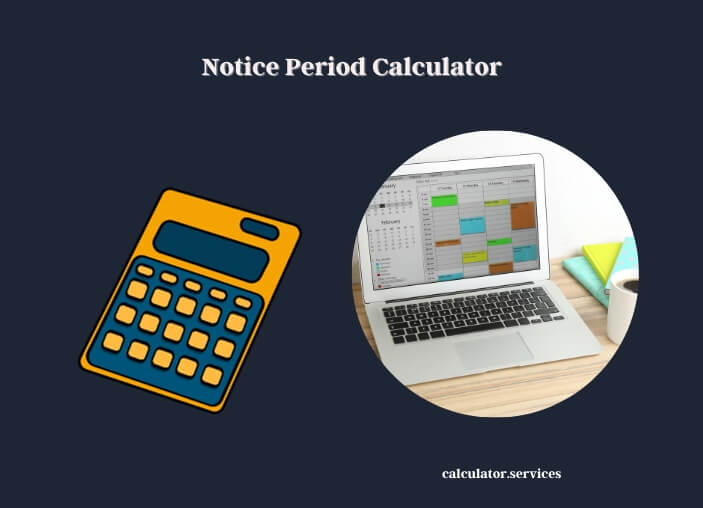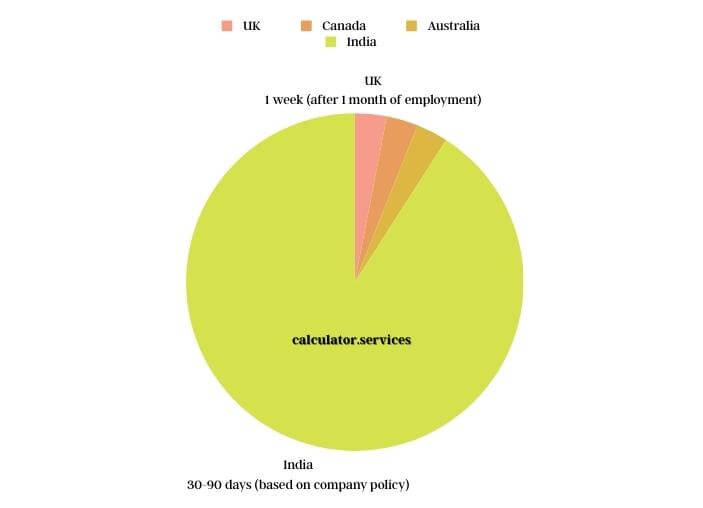Published on: November 24, 2023
Created by Calculator Services Team / Fact-checked by Monjurul Kader
Notice Period Calculator
Results:
Beginning of Notice Period:
Last Day in Contract Term:
Notice Must Be Sent Off By:
Notice Period Begins On:
Days Remaining Until Contract Termination:
The Notice Period Calculator is an essential tool for both employees and employers to determine key dates related to resignation and contract termination. This online calculator simplifies the process of calculating the end date of a notice period, a task often fraught with confusion and errors.
In the realm of employment, understanding the duration of your notice period is vital. The calculator caters to various scenarios, such as a 3-month notice period, a standard 1-month notice, or even a 4-week timeframe. It’s designed to provide clarity and precision, removing the guesswork from these calculations. For those who are planning to resign, the resignation notice period calculator can be particularly useful. It helps in determining the exact date your notice period ends, ensuring compliance with employment contracts.
The tool is also beneficial for HR professionals and managers. It aids in managing staff transitions and maintaining smooth operations. The calculator is versatile, allowing for adjustments based on different notice periods as stipulated in employment contracts. For more complex calculations, such as those needed for a 2-month notice period or specific weekly terms, the tool proves to be invaluable.
Those who prefer managing their data in spreadsheets, the concept behind this calculator can be adapted for notice period calculation in Excel. This flexibility makes it a go-to resource for a wide range of users.
We invite you to read the detailed article below to gain a deeper insight into how the Notice Period Calculator can streamline your resignation or employee management processes. Whether you’re calculating a 4-week notice from today or planning ahead for a longer term, this tool ensures accuracy and ease in your planning.

See More Useful Calculators:
- What’s Missing Loan Calculator
- 375000 Mortgage Calculator
- Bank Statement Loan Calculator
- TikTok Gift Points to Money Calculator
- Pay What You Pull Raffle Calculator
- The Guide to Correct Financial Calculator Usage
- Aglet Profit Calculator
The Basics of Notice Periods
Definition and Importance
Let’s kick things off by getting a clear picture of what a notice period is. Think of it as the time frame between the moment you announce your resignation and your last working day. This period is crucial because it gives both the employee and employer time to adjust to the change. It’s not just about courtesy; it’s about ensuring a smooth transition without disrupting the workflow.
Types of Notice Periods
Notice periods come in different shapes and sizes. Generally, they’re categorized based on their duration – like one month, two months, or even immediate. The type of notice period often depends on the job role, the level of seniority, and the terms of the employment contract.
Legal Aspects of Notice Periods
Employment laws are like the rulebook for notice periods. They vary from country to country, setting the minimum standards for how notice periods should be handled. These laws ensure fairness and prevent any potential exploitation.
Comparison of Notice Period Laws by Country
| Country | Minimum Notice Period | Maximum Notice Period |
| USA | At-will employment (varies by state) | Typically 2 weeks |
| UK | 1 week (after 1 month of employment) | 12 weeks (after 12 years of employment) |
| Canada | 1-8 weeks (based on employment duration) | 8 weeks |
| Australia | 1-4 weeks (based on employment duration) | 4 weeks |
| India | 30-90 days (based on company policy) | 90 days |

Using the Notice Period Calculator
Step-by-Step Guide
Imagine you’ve decided to move on from your current job. You’re wondering, “When will be my last day?” This is where our Notice Period Calculator comes into play. It’s simple: you input your notice date and the duration of your notice period, and voilà, you get your last working day. It’s like having a personal assistant for these tricky calculations.
Practical Examples
Let’s say you hand in your notice on December 1st with a one-month notice period. The calculator will show your last day as December 31st. It’s that easy and saves you the hassle of counting days on your calendar.
Advanced Calculations in Notice Periods
Sometimes, you might face more complex scenarios, like accounting for public holidays or company-specific policies. This is where advanced calculations come into play.
Notice Period Scenarios and Their Calculations
| Scenario | Notice Period | Calculation Result |
| Standard 1-month notice | 1 month from notice date | Exact date one month later |
| 3-month notice with holidays | 3 months from notice date, excluding public holidays | 3 months plus additional days for holidays |
| Immediate resignation | No notice period | Same day as notice date |

Tips for Employers and Employees
Best Practices for Notice Period Management
For employers, it’s about being prepared for these transitions. Have a plan in place for handovers and finding replacements. For employees, it’s about maintaining professionalism. Use this time to wrap up projects and help with the transition.
Common Mistakes to Avoid
One major mistake is not reading your contract thoroughly. You don’t want to assume your notice period and end up breaching your contract. Always double-check to avoid any last-minute surprises.
In a nutshell, the Notice Period Calculator is your go-to tool for figuring out your last working day after resignation. It takes into account various scenarios and simplifies what could be a complex calculation. For both employers and employees, understanding and effectively managing notice periods is key to a smooth transition. So next time you’re in this situation, remember, the calculator is here to make your life easier!
